|
Have a safe day!
Thursday, May 17
2:30 p.m.
Theoretical Physics Seminar - Curia II
Speaker: Martin Jankowiak, SLAC National Accelerator Laboratory
Title: Jet Substructure via Angular Correlations
3:30 p.m.
DIRECTOR'S COFFEE BREAK -
2nd Flr X-Over
4 p.m.
Accelerator Physics and Technology Seminar - One West
Speaker: Ralph Pasquinelli, Fermilab
Title: Microwave Schottky Diagnostic Systems for the Fermilab Tevatron, Recycler, and CERN LHC
Speaker: Sergei Nagaitsev, Fermilab
Title: Design and Simulation of IOTA - a Novel Concept of Integrable Optics Test Accelerator
Friday, May 18
3:30 p.m.
DIRECTOR'S COFFEE BREAK - 2nd Flr X-Over
4 p.m.
Joint Experiment-Theoretical Physics Seminar - One West
Speaker: Markus Wobisch, Louisiana Tech University
Title: Determinations of the Strong Coupling in Jet Production at DZero
8 p.m.
Fermilab Lecture Series - Ramsey Auditorim
Speaker: Dr. Mark Hersam, Northwestern University
Title: The Age of Carbon: Buckyballs, Nanotubes, Graphene, and Beyond
Click here for NALCAL,
a weekly calendar with links to additional information.
Upcoming conferences |
| Thursday, May 18
- Breakfast: Apple sticks
- Santa Fe black bean soup
- Steak tacos
- Chicken Wellington
- Chimichangas
- Baked ham & Swiss on a ciabatta roll
- Assorted sliced pizza
- Smart cuisine: crispy fried chicken salad
Wilson Hall Cafe Menu |
|
Friday, May 18
Dinner
Closed
Wednesday, May 23
Lunch
Guest chef: Veronica Almeraz
- Bistec a la mexicana
- Arroz con frijoles
- Limon mousse
Chez Leon Menu
Call x3524 to make your reservation.
|
|
Scientists celebrate completion of underground physics laboratory
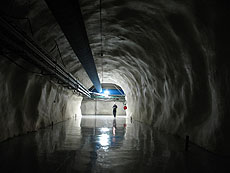 |
| SNOLAB is one big cleanroom underground. Image: SNOLAB |
Editor's note: Fermilab's COUPP experiment, which uses bubble chambers to search for dark matter, is located at SNOLAB. COUPP scientists recently reported their first results.
The elevator that sinks into the Vale Creighton Mine near Sudbury, Ontario, is a gateway to two different worlds. One is Canada's largest nickel mine, opened at the turn of the century and still in operation. The other is SNOLAB, a large underground particle physics laboratory, the grand opening of which will take place today.
To enter the mine, each worker dons the expected garb: sturdy work boots, a bulky work suit and a hard hat with a light attached. But arriving at SNOLAB, located about 1.3 miles beneath the earth, requires a wardrobe change.
Read more
—Kathryn Grim
|
Roland Kulla's work on display in Fermilab Art Gallery
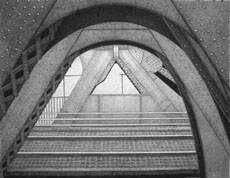 |
| Roland Kulla's Michigan II is one of the drawings in the current Fermilab Art Gallery exhibit.
|
Artist Roland Kulla has spent the last dozen years exploring and capturing bridges, focusing on what he calls "bridge cities" such as Boston, Chicago, New York City, Pittsburgh and, most recently, Berlin.
An exhibit of Kulla's work titled Abstract Jewels of Modernism is on display in the Fermilab Art Gallery through July 14.
Kulla aims to bring the viewer's attention to the bridges' structural logic and to the character each one takes on when seen apart from its surroundings.
"I compose with the camera to abstract elements of the bridge and then render them in a photorealist style," he said. "I'm a self-taught artist. This is my own style. I call it abstract realism."
Kulla shows the bridges in paint, pencil and print with a close-up perspective, inches away from the beams and rivets, so the viewer can enter into the structure.
"We take ordinary things for granted and never really take a close look," he said. "My works provide that view and hopefully demonstrate that even these mundane structures can be beautiful. Scale is important in making a visual impact."
An artist reception will be held in the gallery tomorrow from 5 p.m. to 7 p.m.
—Leah Hesla
|
Strategic Collaborative Initiative: call for proposals
The University of Chicago again seeks proposals for projects that foster collaboration between the university and Fermilab.
"I am pleased to announce the continuation of the Strategic Collaborative Initiative program that supports collaborative research projects between the University of Chicago faculty and Fermilab scientists/engineers," wrote Donald Levy, vice president for research and national laboratories at the University of Chicago in an e-mail to Fermilab scientists.
The University of Chicago funds research projects with the intent to provide the basis for future collaborative research between the University and the laboratory. Ongoing projects that received initial support in the previous year of this program will also be considered for a second year of support.
All proposals require both an applicant from University of Chicago and from Fermilab. University applicants must be PI-eligible. Proposals that include researchers from Argonne National Laboratory as a third applicant will also be considered. Proposal budgets should be in the range of $50,000 to $100,000 for one year.
Applications are due on Wednesday, June 6, 2012. Proposal guidelines and applications can be found here. Additional questions should be directed to Department Manager Kate Kusiak Galvin or Associate Vice President for Program Development and National Laboratories Larry Hill.
|
Thursday: Chat with physicists on Twitter
From symmetry breaking,
May 16, 2012
Thursday at 1 p.m. EDT, accelerator physicists from four national laboratories will take to Twitter to discuss discovery science with the tweeting public. To take part in the event, dubbed Lab Breakthrough Office Hours, use the hashtag #labchat.
Read more
|
|
Higgs search leaves no stone unturned
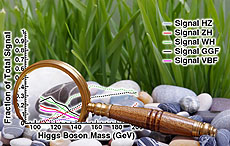 |
| Every search channel counts when looking for the Higgs boson in the remaining allowed mass region.
|
The Higgs boson, the elusive final fundamental particle predicted by the Standard Model, is running out of hiding places. Until the search is over and the Higgs boson is either observed or excluded, efforts remain focused on improving the sensitivity of our search in the remaining allowed mass range.
Currently, two or more experiments exclude Higgs boson masses below 115 GeV and above 129 GeV. Near a Higgs mass of 125 GeV the sensitivity of the combined search at the Tevatron transitions from being dominated by Higgs boson decays into bottom quarks to decays into W bosons. In this transition region, searches in complementary channels are particularly important to the combined search sensitivity.
A recent DZero analysis captures a large number of complementary channels at once by focusing on final states with a tau lepton and an electron or muon. Heavy cousins of the electron, tau leptons are nearly twice as massive as a proton and can decay into neutrinos plus either electrons, muons or hadrons (particles made of quarks). Many processes can lead to a pair of tau leptons, including direct Higgs boson decays and Higgs bosons being produced with or decaying into W or Z bosons that subsequently decay into tau leptons. The analyzers looked for events where one tau lepton decayed into a neutrino and hadrons and the electron or muon came from a tau lepton, W boson, or Z boson decay. Three different categories of hadronic tau decays were considered, and each category was individually optimized.
By combining a large number of Higgs boson production and decay channels, this analysis represents a significant improvement in the Higgs boson search using tau leptons at DZero. The observed exclusion limit is a factor of 15.7 times the Standard Model production rate at a Higgs boson mass of 125 GeV. The signal sensitivity in this analysis is relatively stable across the Higgs boson decay transition region near 125 GeV, where every contribution is important to the final combination.
—Mike Cooke
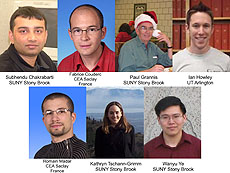 |
| These physicists made major contributions to this analysis.
|
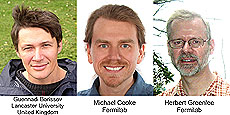 |
| Before the path of a charged particle through the DZero detector can be reconstructed, the position of every element of the tracking detector must be determined accurately. The tracking algorithms group recently completed a series of high precision alignment studies that will benefit all legacy analyses.
|
|
|